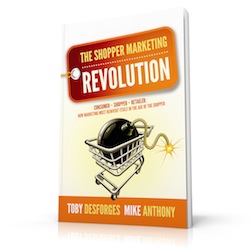 Shopper marketing has the potential to transform the performance of consumer goods companies. Unfortunately this potential is being missed by many as whilst shopper marketing is becoming ubiquitous, effective shopper marketing is still too often elusive. Whilst the digital revolution is changing shopping in ways that are hard to fathom, much of the action focuses on discounts, coupons and price comparisons. Bucket loads of big data are landing on the desks of shopper marketers around the globe, but too much focus appears to be on optimizing what is done now, rather than creating anything radically different. More shopper data runs the danger of creating more silos and analysts, rather than more effective and creative shopper marketers, which is what the industry sorely needs. So if consumer goods companies need shopper marketing to ‘stand up and be counted’ – where should shopper marketing start? How can effective shopper marketing be created, and how might that help the overall performance of consumer goods companies?
Shopper marketing has the potential to transform the performance of consumer goods companies. Unfortunately this potential is being missed by many as whilst shopper marketing is becoming ubiquitous, effective shopper marketing is still too often elusive. Whilst the digital revolution is changing shopping in ways that are hard to fathom, much of the action focuses on discounts, coupons and price comparisons. Bucket loads of big data are landing on the desks of shopper marketers around the globe, but too much focus appears to be on optimizing what is done now, rather than creating anything radically different. More shopper data runs the danger of creating more silos and analysts, rather than more effective and creative shopper marketers, which is what the industry sorely needs. So if consumer goods companies need shopper marketing to ‘stand up and be counted’ – where should shopper marketing start? How can effective shopper marketing be created, and how might that help the overall performance of consumer goods companies?
Targeting is essential for effective shopper marketing
Whilst targeting might seem like an obvious first step to most marketers, sometimes it appears that this goes out of the window when it comes to shopper marketing. The first question has to be “which shoppers am I targeting”? If your brand is targeting shoppers whose decision making process is driven largely by discounts and deals, then read no more – but I’m assuming that the vast majority of brands are reaching for a different group of shoppers. So who is your target shopper?
Your target shopper isn’t your target consumer
Parking for a moment that shoppers aren’t necessarily consumers, it’s important for marketers to distinguish between their target market, and the shoppers that they wish to target. A brand’s target market is the group of individuals with needs the brand most fits (and the brand can meet those needs profitably). The ‘target shopper’ so to speak, is a group of shoppers whose behavior the brand is trying to change (in such a way as to drive profitable consumption growth of a brand). A broad target market may contain all sorts of individual’s whose current relationship to the brand is quite varied (loyalists, occasionals, etc.). A target shopper defines a specific group based on behavior.
And the group we are targeting as shoppers are probably not loyalists. Loyalists already use the brand extensively, one would presume, and so changing their behavior as shoppers isn’t necessarily the most valuable. For online shopper marketing to be effective, we must work out which shoppers are most valuable to the brand, and focus relentlessly on them.
Shoppers who hunt around for discounts aren’t necessarily the best group to target for long term growth: they may love you today but if a fifty cent coupon swayed them into your brand, it might not require much more to sway them out of your brand. And loyal shoppers who always buy your brand may likewise not be the best group to target. So how to identify the target shopper?
Understanding the target shopper begins with understanding the consumer
If a brand’s goal is to grow in the long term (are there any brand managers out there not trying to grow their brands?!? – thought not!), then shopper marketing should focus on those shoppers which can enable long term consumption growth. Understanding this requires an understanding of the consumption opportunities the brand is pursuing.
If a consumer marketing team can identify clearly which consumers have the potential to consume more of the brand; then the shopper marketing targeting process is relatively simple. We should target the shoppers who will enable that consumption to take place. If the largest opportunity for a shampoo brand is to drive penetration amongst teenagers, then the shopper marketing team should target those shopping for shampoo for teenagers. If a coffee brand notices that there is an opportunity to get a certain segment of users to consume the brand more frequently; then the shoppers who buy for those consumers might be the target.
Better targeting also creates better alignment between consumer marketing and shopper marketing
One of the beautiful by-products of this simple process is that there is the opportunity to create much greater alignment between consumer marketing and shopper marketing teams. This integrated targeting approach should ensure that activities are aligned. Our shampoo marketing message to teenagers about the benefits to them of super-shiny hair might align brilliantly with the message sent to their mom’s in-store (or online) that brand X makes teen hair healthy and wholesome. Alternatively, at the very least, the teen at home isn’t going to be disgusted and reject her mom’s choice of shampoo.
Better targeting creates better alignment between marketing and sales
That alignment process extends to retail too. Clarity on who the target consumer is helps create clarity on who the target shopper is. With this knowledge in hand it is possible to identify which stores or channels will be important – they will be the places where the target shopper can be influenced. No longer will we have marketers asking sales teams to execute ‘everywhere’ – a far more refined (and therefore efficient) approach can be taken. This particular opportunity can be activated in the stores where this particular shopper can be found and influenced. The activity the sales team implement is now completely aligned with the goals of the consumer marketing team.
Effective shopper marketing delivers so much more than effective shopper marketing
Sound too good to be true? More effective marketing spend? More effective trade investment? Improved internal alignment? Well, it’s not. I’ve worked with a number of companies to make exactly this a reality. It’s not easy, but the returns are huge. A recent client achieved a return on investment of over 600% in trade spend efficiency alone – not counting the savings in consumer marketing, additional growth, and overall improvements in competency. If you’d like a free consultation on how we could transform the performance of your company, contact me.





[…] taking the short cuts. It is time for shopper marketers to start thinking carefully about who their target shopper is. To think about them as shoppers, not just as consumers. To understand they shopping missions, […]